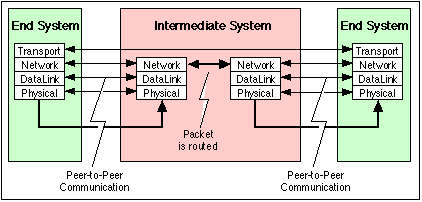
The transport layer is the fourth layer of the OSI reference model. It provides transparent transfer of data between end systems using the services of the network layer (e.g. IP) below to move PDUs of data between the two communicating systems.
The transport service is said to perform "peer to peer" communication, with the remote (peer) transport entity. The data communicated by the transport layer is encapsulated in a transport layer PDU and sent in a network layer SDU. The network layer nodes (i.e. Intermediate Systems (IS)) transfer the transport PDU intact, without decoding or modifying the content of the PDU. In this way, only the peer transport entities actually communicate using the PDUs of the transport protocol.

Two End Systems connected by an Intermediate System (in this case a router) The figure shows the various protocol layers drawn with reference to the OSI reference model
The transport layer relieves the upper layers from any concern with providing reliable and cost effective data transfer. It provides end-to-end control and information transfer with the quality of service needed by the application program. It is the first true end-to-end layer, implemented in all End Systems (ES).
The Internet Protocol (IP) Stack provides a set of transport layer protocols:
| The User Datagram Protocol (UDP) | (Best Effort Service) | |
| The Lighweight User Datagram Protocol (UDP-Lite) | (Best Effort Service) | |
| The Transmission Control Protocol (TCP) | (Reliable Service) (Options) | (Congestion Controlled) |
| The Datagram Congestion Control Protocol (DCCP) | (Reliable Service) (Options) | (Congestion Controlled) |
| The Stream Control Transport Protocol (SCTP) | (Reliable Service) (Options) (Threads) | (Congestion Controlled) |
| SCTP-PR | (Partially Reliable) (Options) (Threads) | (Congestion Controlled) |
Gorry Fairhurst - Date: 1/11/2009